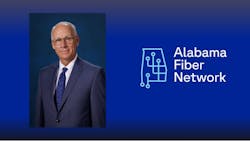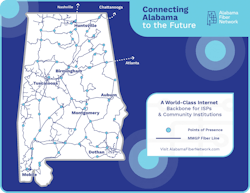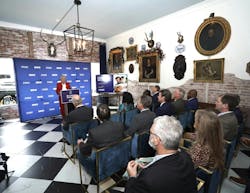Alabama Fiber Network (AFN) wraps first phase of middle mile network
The Alabama Fiber Network (AFN) has finished phase one of the state’s middle-mile broadband backbone, meeting its initial network build-out goal.
As of the end of September, 38 out of 67 counties, or 67% of the project, have been completed.
AFN brings at least 400 Gbps of capacity to each Alabama county with rapid scalability of up to 24 Tbps. That capability will support other broadband providers and direct backbone-grade connections for education, public safety, health care and economic development.
Less than a year ago, the organization set a goal of completing phase one of the grant by the end of September.
Terry Metze, CEO of AFN, said that all the counties it will serve are lit and have a point of presence site and it is negotiating wholesale deals with last mile providers in every region the middle mile network serves.
“We have met over 60 percent of our goal, and by February 1st, our goal is to be at 90 percent,” he said. “The real rural areas of the state will come on probably next summer, getting us to 100 percent.”
Initial growing pains
As a new venture, AFN's initial challenges have been typical of any new business.
Like other providers, AFN has also had to deal with timely delivery of equipment and supplies and the establishment of agreements.
“At times it has been a challenge because we had supply problems,” Metze said. “We had to overcome all the different issues at the contract level and have had a lot of people that have come in and say, ‘We’ll do business with you and iron out the contract later.’”
The provider has been ramping up the infrastructure to run the business, including revenue targets and business development. It is also building up its employee base.
“We now have 15 employees,” Metze said. “We started hiring in July and have this whole staff built up.”
But Metzer and his team are now focusing on the most significant issue: commonality for all electric cooperative partners participating in the AFN network.
“Our engagement right now is we’re trying to get all partners to understand the power of one network management system statewide and how that will make everyone more powerful from quoting, contracting, ordering, and standard pricing,” he said. “We have all these things in place simultaneously while building the network.”
Focus on network resiliency
A vital attribute of AFN is network resiliency.
As a fault-tolerant network, each distribution point on AFN’s network has multiple pathways to adjacent sites and redundant equipment, increasing service availability.
After officially launching the network this summer, AFN announced its first last-mile customer, Sprout Fiber Network, at 100G. Sprout Fiber has added four additional 100G customers, increasing capacity and resiliency and lowering delays.
The AFN network is built on a statewide mesh network consisting of Ciena optical networking gear and Arista routers.
“Usually, a mesh network is built in a campus environment, but we’re building a large mesh network statewide,” Metze said. “Since the network provides so much resiliency, we recently had two significant cable cuts and customers did not experience an outage.”
A collaborative approach
AFN reflects a collaborative approach that has emerged to solve many states' broadband availability issues in recent years.
The AFN emerged after Governor Kay Ivey signed the Connect Alabama Act to drive broadband expansion statewide in 2021.
In 2022, AFN received its initial grant of $82.5 million from the state’s allocation of ARPA funds to construct the middle-mile network.
The state of Alabama has prioritized the middle mile. In early February, it released over $188 million in grants to 12 ISPs to build 4,000 miles of “middle mile” projects.
AFN won a $128.8 million grant to install five middle-mile projects totaling 1,776 miles and connecting 438 anchor institutions in 21 of Alabama counties.
Eight electric cooperatives and their subsidiaries--including Central Alabama Electric Cooperative, Coosa Valley Electric Cooperative, Covington Electric Cooperative, Cooperative Connection LLC (a subsidiary of Cullman Electric Cooperative), JWEMC Communications (a subsidiary of Joe Wheeler Electric Membership Cooperative), North Alabama Electric Cooperative, Tombigbee Electric Cooperative, and PowerSouth Energy Cooperative--collaborated with fiber lease partner Alabama Power Company to deliver middle mile network.
AFN’s owners and partners also contributed, including fiber optic cable strands, storm-hardened locations to place equipment, and other project assistance. This support is helping to accelerate the completion of the statewide backbone.
AFN is engaged with several providers of different flavors. “We are working with everyone, including cooperative telephone companies, electric cooperatives, smaller ISPs, and whoever wants to do business with us so we can cover the entire state of Alabama 100 percent,” Metze said.
He added, “We are very excited about this because this is the first state I have ever seen where companies of such a different ilk are willing to work together to do this.”
All the participating electric cooperatives own the middle mile network, but all work to form the last mile FTTH business units.
AFN has created the FOG (Fiber Operations Group) to oversee its state's last-mile fiber broadband builds.
“The Fiber Operations Group has established a common goal that everyone here is 100 percent committed to fiber-to-home,” Metze said.
BEAD implications
The new AFN network will also have implications for local providers in Alabama applying for the Broadband Equity, Access and Deployment Program (BEAD)
Alabama was awarded more than $1.4 billion from the BEAD program.
In addition to BEAD funding, Alabama has been allocating funds for last-mile and middle-mile projects.
The state’s 66 Capital Projects Fund grants, totaling $148.3 million, were awarded to 16 internet service providers. These grants will expand high-speed internet availability to homes, businesses, and public institutions in portions of 48 counties.
As part of AFN’s middle mile network, it is building spurs off the network for BEAD applicants. The communities the BEAD allocations will support are rural, with a three-house-per-mile density.
“If you have a BEAD application, you must have to have a match or money to be considered for BEAD,” Metze said. “We’re offering up those dark fibers as a match to buy service to connect back to the internet.”
He added, “We’re doing everything possible to support BEAD.”
Statewide is the differentiator
Alabama’s efforts via AFN reflect a growing market trend in the middle mile segment.
Similar collaborative efforts between electric cooperatives exist in states like Arkansas with Diamond State Networks (DSN).
Jonesboro, Arkansas, DSN is owned by 14 of Arkansas’s electric cooperatives, which are combining for the most extensive fiber optic broadband investment in the state’s history. More than $2.2 billion in the network is being constructed across nearly 70% of the state.
Having built middle-mile networks in South Carolina and Georgia, Metze is not a novice to building these networks.
However, he maintains what’s different about AFN is its statewide reach. “There has never been a middle mile this dense,” Metze said. “We are going to have a point of presence in every county so that everyone will have the same equal access across the whole state.”
As it approaches local communities, the initial question is the proximity of the point of presence. “There’s a push me, pull me the process of who gets to have it nearby,” Metze said.
Middle-mile networks have come to light in the past year.
The NTIA’s Enabling Middle Mile Broadband Infrastructure Program funds this part of the nation's high-speed network. With $1 billion in funding, the Program will reduce the cost of bringing high-speed Internet to unserved and underserved communities.
While other states have taken advantage of NTIA's middle mile funding, none of the awards covered an entire state.
Other providers, such as C Spire, Windstream, and Zayo, were given allocations in various states, such as Mississippi and Nevada.
“Much of the middle mile funding was not given to one entity to do the whole state,” Metze said. “A lot of them split it up.”
He added that Alabama’s broadband situation will now be significantly improved. “Alabama was so lacking in broadband, I understand why they did it here,” Metze said.
For related articles, visit the Broadband Topic Center.
For more information on high-speed transmission systems and suppliers, visit the Lightwave Buyer’s Guide.
To stay abreast of fiber network deployments, subscribe to Lightwave’s Service Providers and Datacom/Data Center newsletters.
About the Author
Sean Buckley
Sean is responsible for establishing and executing the editorial strategy of Lightwave across its website, email newsletters, events, and other information products.




